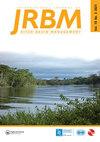加纳小规模非法采矿对地表水和沉积物质量的影响
IF 1.9
Q3 WATER RESOURCES
International Journal of River Basin Management
Pub Date : 2021-11-17
DOI:10.1080/15715124.2021.2002345
引用次数: 7
摘要
摘要在加纳,小规模采矿(SSM)已经开展了多年,创造了就业和收入。目前,非法手工采矿对环境产生了负面影响,导致土地退化和水污染。加纳政府回应公众对“galamsey”负面影响的强烈抗议,于2017年3月禁止非法小规模采矿活动。这项禁令阻止了“合法”的小规模和非法的手工采矿者进行任何此类活动。2018年7月,开展了这项研究,以检查八个非法采矿流行地区的水和沉积物质量状况,以确定河流水质禁令的结果。遵循《水和废水检验标准方法》中的方法。研究结果表明,这些河流的总悬浮固体(TSS)、浊度和颜色都很高,这表明非法采矿活动产生的废水和一些径流流入。颜色与浊度有很强的相关性(r = 0.95)和TSS(r = 0.94),表明污染源相同。在水中和沉积物中都发现了低含量的金属。然而,在水中和沉积物中都检测到非常高浓度的Fe。水柱中的汞浓度较低,但沉积物中的汞含量相对较高。使用水质指数(WQI)对2013年和2018年普拉盆地水体的总体水质状况进行的比较显示,2018年普拉流域的水质比2013年略有改善。2018年水质的改善归功于该禁令。本文章由计算机程序翻译,如有差异,请以英文原文为准。
Effect of small-scale illegal mining on surface water and sediment quality in Ghana
ABSTRACT In Ghana, small-scale mining (SSM) has been carried out for many years, generating employment and income. Currently, illegal artisanal mining (‘galamsey’) has impacted the environment negatively, resulting in land degradation and water pollution. The government of Ghana, responding to public outcry against the negative effects of ‘galamsey’, placed a ban on illegal small-scale mining activities in March 2017. This ban stopped both ‘legal’ small-scale and the illegal artisanal miners from carrying out any such activity. In July 2018, this study was carried out to examine the status of water and sediment quality in eight endemic regions of illegal mining to ascertain the outcome of the ban on the water quality of the rivers. Methodologies in the Standard Methods for the Examination of Water and Wastewater were followed. Results of the study indicated that the rivers were high in total suspended solids (TSS), turbidity and colour, suggesting inflow of wastewater from the illegal mining activities and some run-off. Colour had a strong correlation with turbidity (r = 0.95) and TSS (r = 0.94), suggesting that the pollution originates from the same sources. Low levels of metals were found in both water and sediment. However, very high concentrations of Fe were detected in both water and sediment. Mercury concentrations were low in the water column but relatively higher in the sediment. A comparison of the general water quality status of the water bodies in the Pra Basin in 2013 and 2018 using the Water Quality Index (WQI) showed a marginal improvement in quality in 2018 over 2013 in the Pra Basin. The improvement of water quality in 2018 is attributable to the ban.
求助全文
通过发布文献求助,成功后即可免费获取论文全文。
去求助
来源期刊

International Journal of River Basin Management
WATER RESOURCES-
CiteScore
6.00
自引率
4.00%
发文量
48
期刊介绍:
include, but are not limited to new developments or applications in the following areas: AREAS OF INTEREST - integrated water resources management - watershed land use planning and management - spatial planning and management of floodplains - flood forecasting and flood risk management - drought forecasting and drought management - floodplain, river and estuarine restoration - climate change impact prediction and planning of remedial measures - management of mountain rivers - water quality management including non point source pollution - operation strategies for engineered river systems - maintenance strategies for river systems and for structures - project-affected-people and stakeholder participation - conservation of natural and cultural heritage
 求助内容:
求助内容: 应助结果提醒方式:
应助结果提醒方式:


